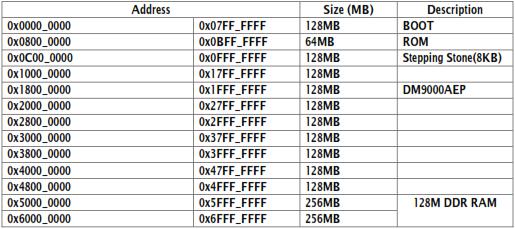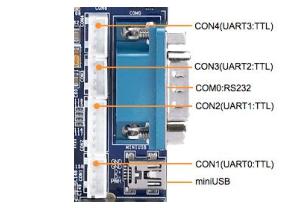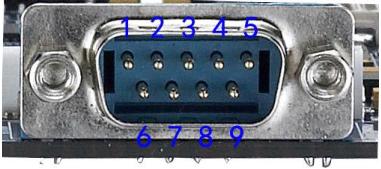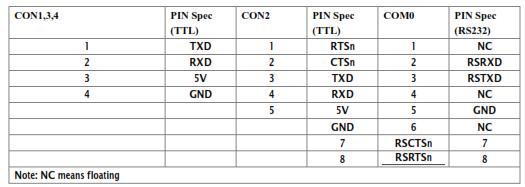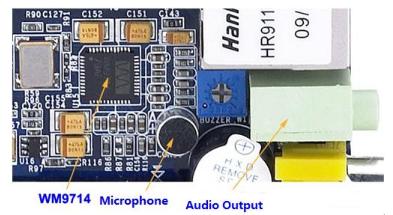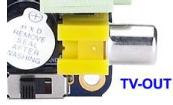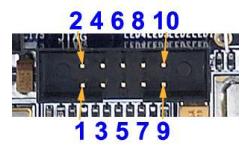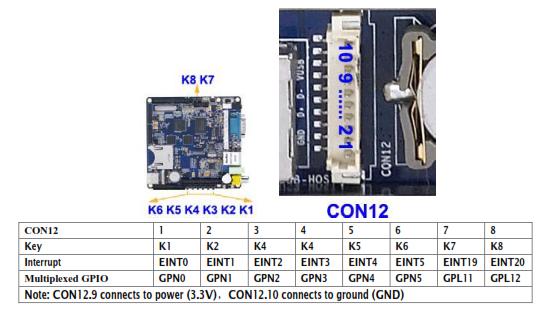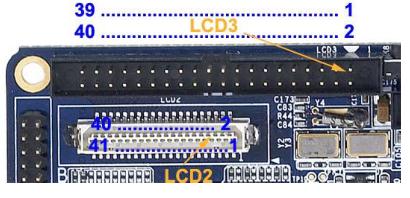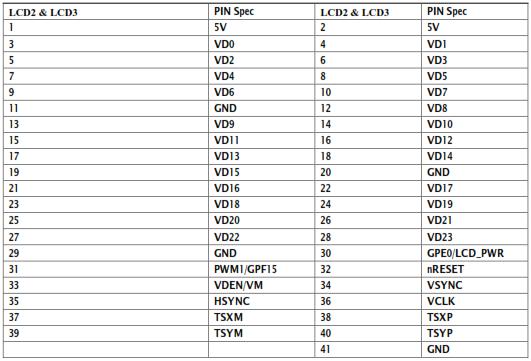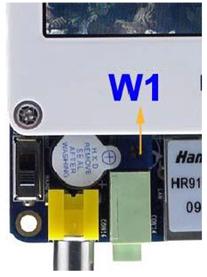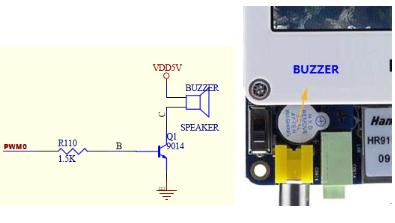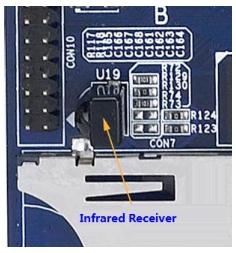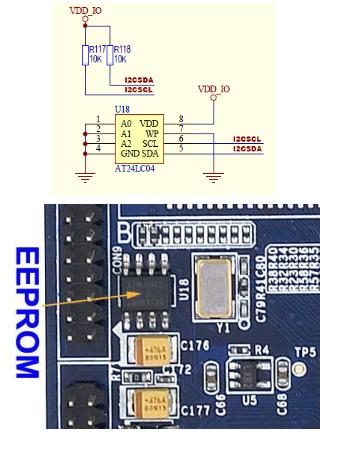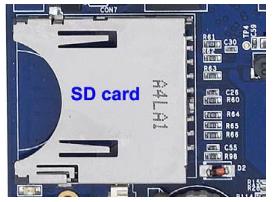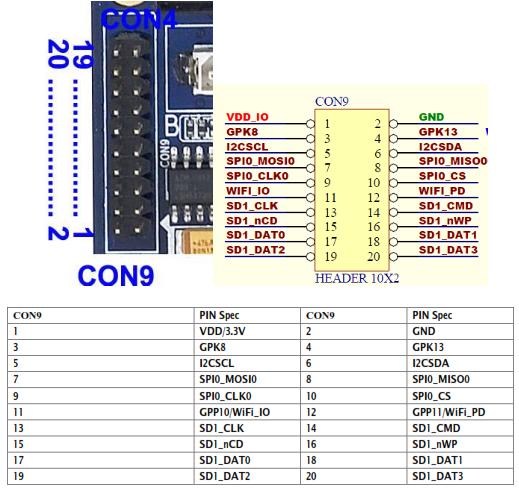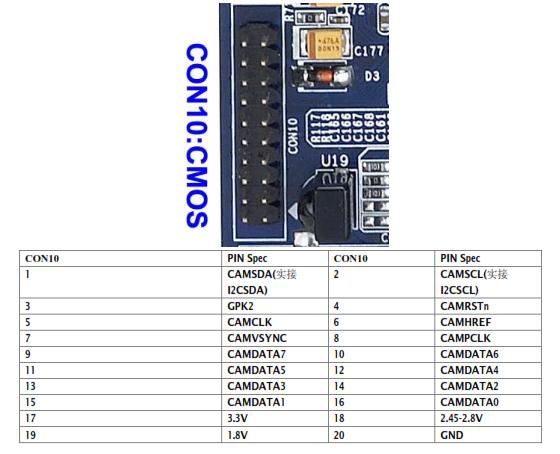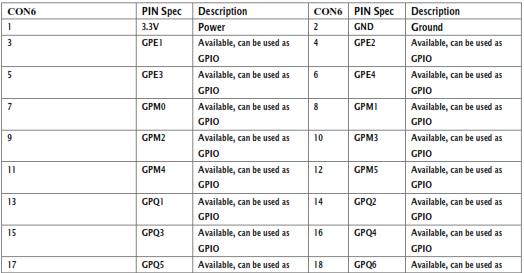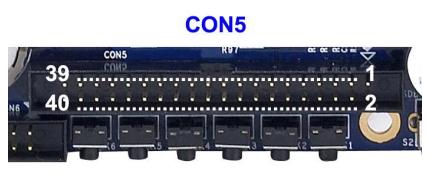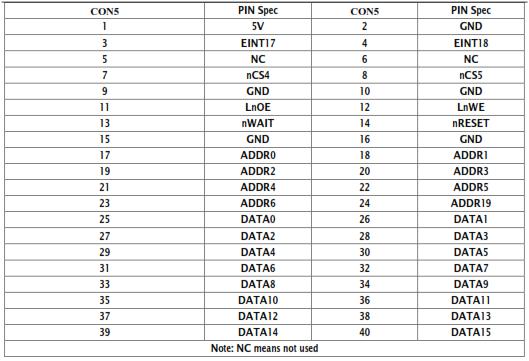Difference between revisions of "Mini6410 Hardware Specification"
| Line 1: | Line 1: | ||
== Address Space == | == Address Space == | ||
The following data is from the S3C6410 data sheet | The following data is from the S3C6410 data sheet | ||
| − | + | ||
| − | == Power == | + | [[File:Mini6410 hard1.jpg]] |
| + | |||
| + | ==Power == | ||
The Mini6410 is powered by an external 5V power supply. It has two power inlets: CN1 is | The Mini6410 is powered by an external 5V power supply. It has two power inlets: CN1 is | ||
for 5V power adapter and the white CON8 is a 4 pin socket used to connect an external | for 5V power adapter and the white CON8 is a 4 pin socket used to connect an external | ||
power supply when the board is embedded in a closed box. The voltage is 5V and current is | power supply when the board is embedded in a closed box. The voltage is 5V and current is | ||
800mA. | 800mA. | ||
| − | + | ||
| + | [[File:Mini6410 hard2.jpg]] | ||
| + | |||
== Serial Port == | == Serial Port == | ||
S3C6410 has 4 serial ports: UART0, 1, 2 and 3. UART0 and 1 are 5 wire serial ports and | S3C6410 has 4 serial ports: UART0, 1, 2 and 3. UART0 and 1 are 5 wire serial ports and | ||
| Line 14: | Line 18: | ||
via a serial port cable. | via a serial port cable. | ||
The rest 4 ports are connected to CPU via CON1-4. They are presented as below: | The rest 4 ports are connected to CPU via CON1-4. They are presented as below: | ||
| − | + | ||
| − | + | [[File:Mini6410 hard3.jpg]] | |
| − | + | ||
| + | [[File:Mini6410 hard4.jpg]] | ||
| + | |||
| + | [[File:Mini6410 hard5.jpg]] | ||
| + | |||
== USB Interface == | == USB Interface == | ||
| Line 26: | Line 34: | ||
Mini USB interface: | Mini USB interface: | ||
| − | + | ||
| + | [[File:Mini6410 hard6.jpg]] | ||
USB Host: | USB Host: | ||
| − | + | ||
| + | [[File:Mini6410 hard7.jpg]] | ||
| Line 45: | Line 55: | ||
source when recording. | source when recording. | ||
| − | + | [[File:Mini6410 hard8.jpg]] | |
== TV Output == | == TV Output == | ||
| Line 54: | Line 64: | ||
Note: when connecting DACOUT0 to a TV users need to switch the TV to the CVBS mode. | Note: when connecting DACOUT0 to a TV users need to switch the TV to the CVBS mode. | ||
| − | + | [[File:Mini6410 hard9.jpg]] | |
| Line 79: | Line 89: | ||
system. This is not an easy job. | system. This is not an easy job. | ||
| − | + | [[File:Mini6410 hard10.jpg]] | |
| − | + | ||
| + | [[File:Mini6410 hard11.jpg]] | ||
| Line 88: | Line 99: | ||
Detailed information is as follows | Detailed information is as follows | ||
| − | + | [[File:Mini6410 hard12.jpg]] | |
| Line 97: | Line 108: | ||
CON12 are defined as follows | CON12 are defined as follows | ||
| − | + | [[File:Mini6410 hard13.jpg]] | |
| − | |||
== Double LCD Interface == | == Double LCD Interface == | ||
| Line 114: | Line 124: | ||
4 wire resistor touch screen.<br> | 4 wire resistor touch screen.<br> | ||
| − | + | [[File:Mini6410 hard14.jpg]] | |
| − | + | ||
| + | [[File:Mini6410 hard15.jpg]] | ||
| Line 127: | Line 138: | ||
even when the board is equipped with a 4.3-inch LCD. | even when the board is equipped with a 4.3-inch LCD. | ||
| − | + | [[File:Mini6410 hard16.jpg]] | |
== PWM Buzzer == | == PWM Buzzer == | ||
| Line 134: | Line 145: | ||
GPIO. | GPIO. | ||
| − | + | [[File:Mini6410 hard17.jpg]] | |
| − | |||
| Line 142: | Line 152: | ||
connects to EINT12. | connects to EINT12. | ||
| − | + | [[File:Mini6410 hard18.jpg]] | |
| Line 148: | Line 158: | ||
The Mini6410 has an EEPROM AT24C08 connected to CPU’s I2C. It has 256 bytes | The Mini6410 has an EEPROM AT24C08 connected to CPU’s I2C. It has 256 bytes | ||
memory and is mainly for testing I2C bus. | memory and is mainly for testing I2C bus. | ||
| − | + | ||
| + | [[File:Mini6410 hard19.jpg]] | ||
| Line 156: | Line 167: | ||
i.e. high speed large memory SD cards. | i.e. high speed large memory SD cards. | ||
| − | + | [[File:Mini6410 hard20.jpg]] | |
| Line 163: | Line 174: | ||
connector and includes an SPI, an I2C and 4 GPIOs. | connector and includes an SPI, an I2C and 4 GPIOs. | ||
| − | + | [[File:Mini6410 hard21.jpg]] | |
| + | |||
== CMOS Camera Interface == | == CMOS Camera Interface == | ||
The S3C6410 has a CMOS camera interface. It is extended via CON10. It is a 20 pin | The S3C6410 has a CMOS camera interface. It is extended via CON10. It is a 20 pin | ||
| Line 173: | Line 185: | ||
corresponding registers. The schematic below presents its pin details. | corresponding registers. The schematic below presents its pin details. | ||
| − | + | [[File:Mini6410 hard22.jpg]] | |
| Line 183: | Line 195: | ||
They can be configured for other purposes too by setting related CPU registers. | They can be configured for other purposes too by setting related CPU registers. | ||
| − | + | [[File:Mini6410 hard23.jpg]] | |
| − | + | ||
| + | [[File:Mini6410 hard24.jpg]] | ||
| Line 193: | Line 206: | ||
the detailed information about CON5’s pins | the detailed information about CON5’s pins | ||
| − | + | [[File:Mini6410 hard25.jpg]] | |
| − | + | [[File:Mini6410 hard26.jpg]] | |
Latest revision as of 06:33, 27 June 2012
Contents
- 1 Address Space
- 2 Power
- 3 Serial Port
- 4 USB Interface
- 5 Network Interface
- 6 Audio Interface
- 7 TV Output
- 8 JTAG Interface
- 9 LED
- 10 User Key
- 11 Double LCD Interface
- 12 ADC Input
- 13 PWM Buzzer
- 14 Infrared Receiver
- 15 I2C-EEPROM
- 16 SD Card
- 17 SDIO-II//SD-WiFi
- 18 CMOS Camera Interface
- 19 GPIO
- 20 System Bus
Address Space
The following data is from the S3C6410 data sheet
Power
The Mini6410 is powered by an external 5V power supply. It has two power inlets: CN1 is for 5V power adapter and the white CON8 is a 4 pin socket used to connect an external power supply when the board is embedded in a closed box. The voltage is 5V and current is 800mA.
Serial Port
S3C6410 has 4 serial ports: UART0, 1, 2 and 3. UART0 and 1 are 5 wire serial ports and the other two are 3 wire serial ports. On this board, UART0 is converted via RS232 to COM0 and can communicate with a PC via a serial port cable. The rest 4 ports are connected to CPU via CON1-4. They are presented as below:
USB Interface
The Mini6410 board has two USB interfaces. One is a USB host 1.1 which is the same as a USB interface on a PC and can connect to a USB camera, keyboard, mouse, flash drive and other USB devices. The other is an OTG mini USB 2.0 which is usually used to download programs to a target board. When the board runs WinCE it can synchronize with a Windows via ActiveSync. For Linux there are no programs for synchronization for now.
Mini USB interface:
USB Host:
Network Interface
The Mini6410 incorporates a DM9000 chip and can communicate with 10/100M networks. The RJ45 connector includes coupling filters and does not need transformers. With a common network cable, you can connect a router or switch to the Mini6410.
Audio Interface
The S3C6410 supports I2S/PCM/AC97. The Mini6410 has an AC97 interface which uses
WM9714 as the CODEC chip.
The audio output is a 3.5 mm spaced green plug and the input is an on-board microphone. To get better audio quality please move the microphone as close as possible to the audio source when recording.
TV Output
The S3C6410 has two TV outputs. The Mini6410 magnifies the output of DACOUT0,
users can connect the board to a TV via an AV cable. The other TV output is extended from
CPU to the 30th pin of CON6.
Note: when connecting DACOUT0 to a TV users need to switch the TV to the CVBS mode.
JTAG Interface
When a board just comes off from production lines it is just a bare board without any data
and we usually have to burn the first program to it through the JTAG interface. However since
the S3C6410 supports booting from SD card the JTAG is not significant to users any more.
Now the JTAG is more often used for debugging. In fact, most of the widely used utilities in
markets like JLINK, ULINK and other simulators actually work via the JTAG interface. A
standard JTAG has 4 signals :TMS, TCK, TDI and TDO which are test mode select input, test
clock, test data input and test data output. These 4 signal lines plus a power line and a ground
line form 6 lines in total. In order for testing, most simulators even have a reset signal.
Therefore, a standard JTAG is meant to have those signal lines, and it does not mean whether it
is 20Pin or 10Pin. As long as a JTAG interface has those signal lines, it will be a standard
JTAG interface. The Mini6410 has a 10Pin JTAG interface which has complete standard
JTAG signals.
Notes: for beginners who just want to focus on Linux or WinCE development, the JTAG interface has no significance because most development boards already have a complete BSP which includes commonly needed serial ports, network port and USB port. When a board runs with Linux or WinCE installed, users can fully utilize more convenient functions and utilities provided by the operating system to debug. They do not need a JTAG. Even if you can trace your programs it will be extremely tough to step debug because it will go into the operating system. This is not an easy job.
LED
A LED is commonly used as a status indicator. The Mini6410 has 4 user programmable LEDs which are directly connected to GPIO. The LEDs will be on at a low level voltage. Detailed information is as follows
User Key
The Mini6410 has 8 test keys. They all are CPU interrupt input signals and will be triggered at a low level voltage. They can also be multiplexed to GPIO and other function interfaces. To multiplex them users can extend them through CON12. These 8 keys and CON12 are defined as follows
Double LCD Interface
For users’ convenience we incorporate two LCD interfaces on the board: LCD2 and LCD3.
LCD2 is a 0.5mm spaced 41 pin connector and compatible with Mini2440 LCD; LCD3 is a
2.0mm spaced 40 pin connector. Since LCD2.41 is grounded LCD3 can still work although
it lacks one pin.
The LCD connector has most of the commonly used control signals (line sweeping, clock,
enable/disable) and complete RGB data signals (RGB output is 8:8:8 and can support LCDs
up to 1.6M pixels). It has a PWM output and a reset signal (nRESET). LCD_PWR is the
backlight switch signal.
37, 38, 39 and 40 are a 4 wire touch screen interface which can be directly connected to a
4 wire resistor touch screen.
ADC Input
The Mini6410 has 4 A/D conversion channels. AIN0 is connected to the adjustable resistor
W1; AIN1, 2 and 3 are extended via CON6’s 27, 28 and 29. The S3C6410’s AD conversion
can be configured to 10-bit/12-bit. For more details please refer to Chapter 39 of the data
sheet.
For users’ convenience, W1 is placed close to one edge of the board and will not be hidden even when the board is equipped with a 4.3-inch LCD.
PWM Buzzer
The on-board SPEAKER is controlled by PWM, the diagram is shown below. PWM0 corresponds to GPF14 which can be configured as PWM output via software or used as a GPIO.
Infrared Receiver
The Mini6410 has an infrared receiver. Its type is IRM3638 (or others compatible). It connects to EINT12.
I2C-EEPROM
The Mini6410 has an EEPROM AT24C08 connected to CPU’s I2C. It has 256 bytes memory and is mainly for testing I2C bus.
SD Card
The S3C6410 has two SDIO interfaces. SDIO0 is commonly used for SD cards. The Mini6410 makes a standard SD card slot by extending SDIO0 via CON7. It supports SDHC i.e. high speed large memory SD cards.
SDIO-II//SD-WiFi
The other SDIO of the S3C6410 is extended via CON9. It is a 2.0 mm spaced 20 pin connector and includes an SPI, an I2C and 4 GPIOs.
CMOS Camera Interface
The S3C6410 has a CMOS camera interface. It is extended via CON10. It is a 20 pin
2.0mm connector, users can directly use the CAM130 module we provide. The CAM130
module does not have any circuits. It is basically just a converter and directly connects to a
ZT130G2 camera module.
Notes: the camera interface is a multiplexed port. It can be used as GPIO by setting corresponding registers. The schematic below presents its pin details.
GPIO
GPIO is the abbreviated form of General Purpose Input Output. The Mini6410 has a 30 Pin 2.0mm spaced GPIO interface, i.e. CON6. In fact, CON6 has not only quite a few GPIO pins but also some CPU pins such as AD input, DAC and so on. The SPI interface, I2C interface, interrupts and some others are all GPIOs, but they are marked as special function interfaces. They can be configured for other purposes too by setting related CPU registers.
System Bus
The system bus is CON5. It contains 16 data lines (D0-D15), 8 address lines (A0-A6, A24), and some control signal lines (such as chip select, read/write, reset and so on). CON5 can supply 5V output. In fact very few users would extend interfaces through system bus. Below is the detailed information about CON5’s pins
